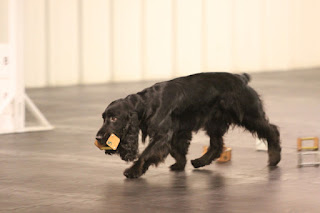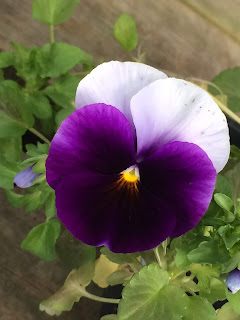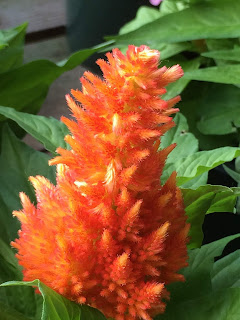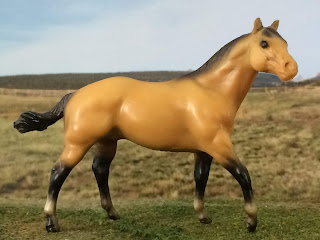Ah, to explain the worlds of modeldom...
Scale Model animals are shown much like their real counterparts - and judged on a variety of criteria.
First off we have photo shows which can be done from a distance...photographs of the model display its unique appearance and are judged in classes with similar entries. This is done by mail or online. Live shows are in person at a show hall with tables, and the models are seen from all angles, not in two dimensions.
Here is a typical “halter” photo for a model horse:

Ways they are judged depend on division and the philosophy of a judge.
Halter or Breed or Conformation
This division is looking at how an animal is put together - how it “conforms” to its breed standard.
A sculpture should be “true to type” in representation of a particular breed based on characteristics set forth in a breed standard. This involves everything from its head properties to the length and shape of body parts - neck, shoulder, forequarters, back, legs, hindquarters, tail and also color and markings.
Live animals are also judged on their temperament and gait or movement which must be captured in a moment for the static sculpture.
My judging philosophy in this realm also covers ABC - Anatomy, Biomechanics, and Conformation. Models need to represent their assigned breed and have proper sculpting for that animal - does it appear to have balance and symmetry as a live animal would? Are the joints and parts realistic and plausible? Does the model represent breed characteristics in good form? “Gender” assignments also matter as a cresty-necked Stallion has different characteristics than that of a Mare or Gelding. Assigned age can also come into play as animals display variable characteristics in color, physical body, as well as behavior! Consider the leggy cavorting foal as compared to wise aging well-broke gelding. As judges and exhibitors, we have to do our homework and study breeds! Documentation for rare breeds or color examples may be used.
Finishwork/Workmanship and also Color Classes

When models are factory created and finished or customized by secondary artists or hobbyists, an overall picture is created. Sometimes there is great shading and detail, sometimes not. Flaws like overspray or paint globs happen. Original Finish can get rubbed or scratched. Eartips, hoof edges, and nostril edges and eyes are especially prone to damage. The customized model, whether remade or a painted artist resin, may also have flaws, lack smoothness, or incur damage. Makes and tails might be haired or sculpted. Joints might have been moved and resculpted. Colors or markings might not be well-blended or plausible. Pinto and appaloosa patterns should be realistic and correct. The “wow” factor and prettiness is an appeal for some judges. It should be noted that every artist paints with a different brush, and technique and style differ from piece to piece. Customizing and finish should be flawless and smooth.
Collectibility

Rare, old, and preserved pieces are amazing! From the early models to scarce pieces, it is a treat to see vintage works. Some models are unique or were produced as special limited runs. Documentation and/or provenance can be helpful in terms of explaining the history or collectibility of the piece. We are also seeing a resurgence of Vintage Customs and Vintage Resins from earlier years that have stood the rest of time. Correctness of older molds according to Breed type and fashion is not of concern when it comes to this division - it is all about condition, rarity, or history!
Suitability
Not often seen, but very valuable in terms of education, this refers to how well a model
would be for particular activities. When considering a piece for performance, we observe gait, frame, way of going, and headset in terms of suitability for specific disciplines or events. For example, a long strided, fast, head-up horse could do cross country or speed events/gaming but not suitable as a hunter or pleasure horse. Specific positions lend themselves well to certain events. This was a super set of classes for the youth or amateurs learning to show.
Performance

Models are judged on how they are carrying out specific events. Riders are not required but mayblend ontealism. Props need to be spaced correctly and in scale, and tack should be properly fitted and correct for the class. Proper gaits and headsets are necessary and documentation helps to explain what is going on, as in part of a test or pattern.
Generally there are English and Western events including jumping and stockwork, trail and games, and there is Harness, Costume, and other types of performance as well. Emphasis is on the “freeze frame” moment in time captured of a performance, not just the model itself. Some models are very versatile and can do many events while others are more “specialists” in a given event or set of events. Even Non-ridden performance such as showmanship or packing may be detailed. Much planning and effort goes into performance setups and it is lots of fun!
Other/Misc. And “Fun” classes
Sometimes other classes are judged, from “anything goes” to other animals, to personal favorites or family classes. Fantasy and Medallions can be their own class or division or can be put alongside the fun theme classes depending on the show.
NAMHSA or North American Model Horse Showers Association offers Merit Awards and National competition for models that qualify by earning cards at approved shows for 1st or 2nd place in classes. Many theme or fun shows are popping up that range from home gatherings to fundraisers to events in conjunction with swap meets, festivals, or other model events.
Model showing is a fun, educational, rewarding activity that can be social as well. Enjoy!

















































